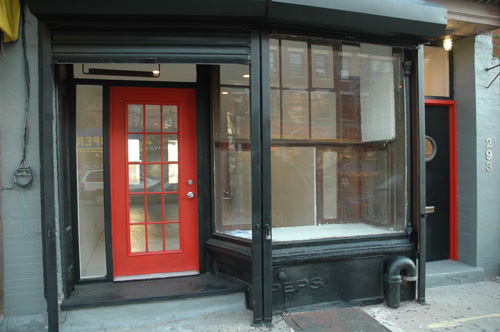Red hot Red Hook? How's 'lukewarm'?

Gowanus Lounge's take on Red Hook is in the Brooklyn Papers this week, which hits all around our borough starting today. It's paired with an excellent story by Ariella Cohen about local developer and pizza entrepreneur Gino Vitale headlined "A slice of Red Hook." (Given that Ariella is one of the people whose work teaches us much about Brooklyn, it's way cool to be on the same page as her fine work.)
As for our own article, it's headlined "Red hot Red Hook? How's 'lukewarm'?" We're going to reproduce it here:
Dianna Munz knows hot.
She was a founding member of Smith Street’s “Restaurant Row” when she opened Panino’teca in Carroll Gardens and, then, took on Red Hook when she and her partner opened Hope & Anchor on Van Brunt Street.
“Good things are happening,” said Munz, whose diner sits at the intersection of Van Brunt and Wolcott streets in a two-block stretch that includes the restaurant 360, the Atlantis antique shop and the Kentler International Drawing Space, an original Red Hook pioneer.
“But smart people are looking around and saying, ‘It’s not there yet’,” Munz said.
Come again? Red hot Red Hook is “not there yet”?
Is Munz talking about the same neighborhood that Manhattan-based newspapers and magazines — even out-of-town ones like the Washington Post — have been proclaiming New York City’s newest hot and trendy neighborhood?
Yes, and with good reason. Even though the selling price of Red Hook properties has doubled in two years and its packs of wild waterfront dogs have been housebroken, rumors of the next Williamsburg are clearly premature or, at least, byproducts of the need for headlines about “hip” neighborhoods.
“I’ve seen people coming from the cruise terminal looking around like they’re wondering ‘What’s here?’” said Corie Trancho-Robie, a Red Hook resident who produces the blog Callalillie.
The hapless tourist venturing into The Hook, in fact, might not “get it” at all, especially on streets where the landscape still runs to post-industrial apocalypse. The reality is that despite the ongoing openings of new restaurants and shops, there are still far more empty storefronts and “for rent” signs than actual businesses on Van Brunt Street, the neighborhood’s main commercial drag.
“All the attention created very high expectations, but we could have used another year or two,” said Steve McFarland, a resident who runs B61 Productions, a Web site dedicated to community issues. “People coming down here might be disappointed.”
Generally, media hype about “red hot” Red Hook focuses on the galleries and shops clustered around Van Brunt Street or the Beard Street Piers, but the rest of the neighborhood has residents who have lived there for decades and businesses that fill the streets with trucks on weekdays.
“Red Hook is changing both as a business community and as place to live,” said Brooklyn Chamber of Commerce President Kenneth Adams, who measures the timeframe for Red Hook growth in years, not months.
Two-thirds of Red Hook’s residents live in public housing and, for them, businesses like Ikea that promise to produce jobs by the hundreds are of more interest than a wine bar that may attract Yuppies, yet hires just four people.
John McGettrick, who co-chairs the Red Hook Civic Association, called the neighborhood a “diamond in the rough” — and its rough edges stem from a lack of transportation and services; residents are fighting just to get a stoplight put in on Van Brunt Street.
“Everyone wants to do a sexy business like a bar or a cafe, but we still need a community bank,” said LeNell Smothers, an Alabama native who moved to Red Hook and opened LeNell’s, a high-end wine and liquor shop, in 2003. Smothers said her business does well, but that a significant online presence in her niche market has helped.
Because many visitors are weekend warriors, many Red Hook businesses are only open Thursday through Sunday. Artist Mary Ellen Buxton, who opened the Pier Glass studio in Red Hook in 1993, said the neighborhood needs more residents before it can support a large number of businesses.
“It’s a very fine balance,” she said.
Others were not certain the balance had been found.
“We’re happy that people want to come to Red Hook, but I hope they do more than fly down the street to Fairway to get a filet mignon,” said Florence Neal, whose Kentler gallery opened in 1990 when people were still terrified of venturing past the Gowanus Expressway or over the Battery Tunnel to visit the neighborhood.
Munz of Hope & Anchor and other merchants, though, are banking on Red Hook’s future. She and her partners are talking about opening another Red Hook eatery.
“When all is said and done,” Munz said, “things are happening here, but I think it’s a 10-year window.”
Ironically, one reason that change is so slow to come to Red Hook is that landlords aren’t willing to make a little less money now in exchange for riches later.
Ataur Miah, co-owner of Bombay Dream on Smith Street, said more restaurants would be moving into the neighborhood if landlords were open to long leases.
“Many restaurants are looking, but landlords now only want [short] leases because they know in a few years they will be able to charge more,” Miah said. “But restaurants need long leases.”
The owners of the pioneering restaurant Patois, which opened on Smith Street long before it became a destination for gourmands, are also looking into opening in Red Hook, according to local brokers and workers at the restaurant.
That didn’t surprise Miah, who says he is going to open soon in Red Hook.
“It’s a very good neighborhood and it will only get better,” he said.

0 Comments:
Post a Comment
<< Home